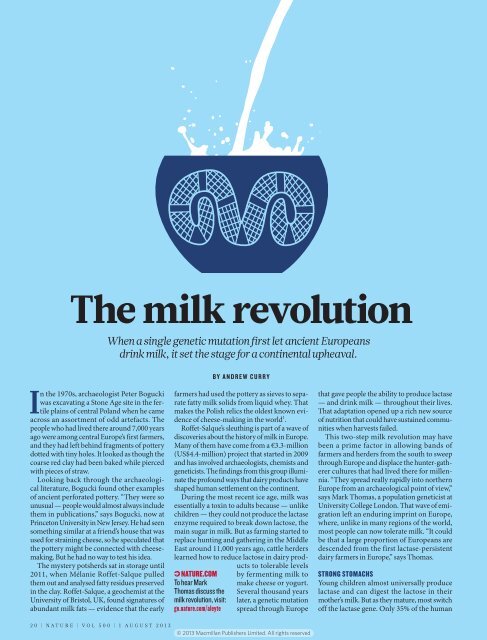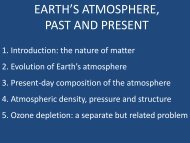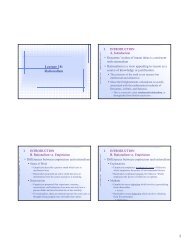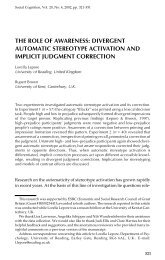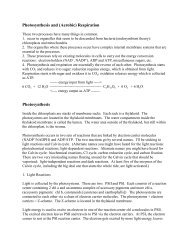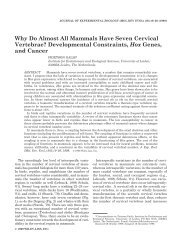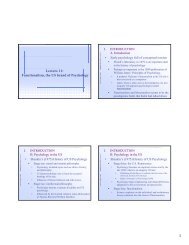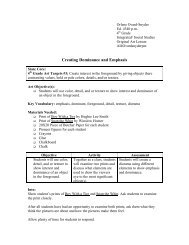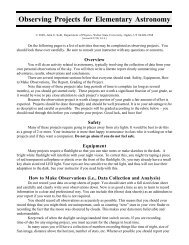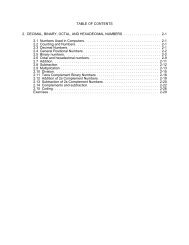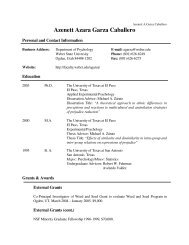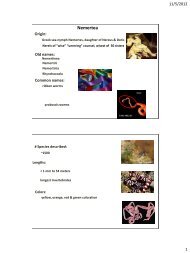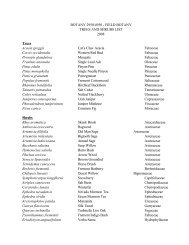The milk revolution - Weber State University
The milk revolution - Weber State University
The milk revolution - Weber State University
You also want an ePaper? Increase the reach of your titles
YUMPU automatically turns print PDFs into web optimized ePapers that Google loves.
<strong>The</strong> <strong>milk</strong> <strong>revolution</strong><br />
When a single genetic mutation first let ancient Europeans<br />
drink <strong>milk</strong>, it set the stage for a continental upheaval.<br />
BY ANDREW CURRY<br />
In the 1970s, archaeologist Peter Bogucki<br />
was excavating a Stone Age site in the fertile<br />
plains of central Poland when he came<br />
across an assortment of odd artefacts. <strong>The</strong><br />
people who had lived there around 7,000 years<br />
ago were among central Europe’s first farmers,<br />
and they had left behind fragments of pottery<br />
dotted with tiny holes. It looked as though the<br />
coarse red clay had been baked while pierced<br />
with pieces of straw.<br />
Looking back through the archaeological<br />
literature, Bogucki found other examples<br />
of ancient perforated pottery. “<strong>The</strong>y were so<br />
unusual — people would almost always include<br />
them in publications,” says Bogucki, now at<br />
Princeton <strong>University</strong> in New Jersey. He had seen<br />
something similar at a friend’s house that was<br />
used for straining cheese, so he speculated that<br />
the pottery might be connected with cheesemaking.<br />
But he had no way to test his idea.<br />
<strong>The</strong> mystery potsherds sat in storage until<br />
2011, when Mélanie Roffet-Salque pulled<br />
them out and analysed fatty residues preserved<br />
in the clay. Roffet-Salque, a geochemist at the<br />
<strong>University</strong> of Bristol, UK, found signatures of<br />
abundant <strong>milk</strong> fats — evidence that the early<br />
NATURE.COM<br />
To hear Mark<br />
Thomas discuss the<br />
<strong>milk</strong> <strong>revolution</strong>, visit:<br />
go.nature.com/aleyte<br />
farmers had used the pottery as sieves to separate<br />
fatty <strong>milk</strong> solids from liquid whey. That<br />
makes the Polish relics the oldest known evidence<br />
of cheese-making in the world 1 .<br />
Roffet-Salque’s sleuthing is part of a wave of<br />
discoveries about the history of <strong>milk</strong> in Europe.<br />
Many of them have come from a €3.3-million<br />
(US$4.4-million) project that started in 2009<br />
and has involved archaeologists, chemists and<br />
geneticists. <strong>The</strong> findings from this group illuminate<br />
the profound ways that dairy products have<br />
shaped human settlement on the continent.<br />
During the most recent ice age, <strong>milk</strong> was<br />
essentially a toxin to adults because — unlike<br />
children — they could not produce the lactase<br />
enzyme required to break down lactose, the<br />
main sugar in <strong>milk</strong>. But as farming started to<br />
replace hunting and gathering in the Middle<br />
East around 11,000 years ago, cattle herders<br />
learned how to reduce lactose in dairy products<br />
to tolerable levels<br />
by fermenting <strong>milk</strong> to<br />
make cheese or yogurt.<br />
Several thousand years<br />
later, a genetic mutation<br />
spread through Europe<br />
that gave people the ability to produce lactase<br />
— and drink <strong>milk</strong> — throughout their lives.<br />
That adaptation opened up a rich new source<br />
of nutrition that could have sustained communities<br />
when harvests failed.<br />
This two-step <strong>milk</strong> <strong>revolution</strong> may have<br />
been a prime factor in allowing bands of<br />
farmers and herders from the south to sweep<br />
through Europe and displace the hunter-gatherer<br />
cultures that had lived there for millennia.<br />
“<strong>The</strong>y spread really rapidly into northern<br />
Europe from an archaeological point of view,”<br />
says Mark Thomas, a population geneticist at<br />
<strong>University</strong> College London. That wave of emigration<br />
left an enduring imprint on Europe,<br />
where, unlike in many regions of the world,<br />
most people can now tolerate <strong>milk</strong>. “It could<br />
be that a large proportion of Europeans are<br />
descended from the first lactase-persistent<br />
dairy farmers in Europe,” says Thomas.<br />
STRONG STOMACHS<br />
Young children almost universally produce<br />
lactase and can digest the lactose in their<br />
mother’s <strong>milk</strong>. But as they mature, most switch<br />
off the lactase gene. Only 35% of the human<br />
20 | NATURE | VOL 500 | 1 AUGUST 2013<br />
© 2013 Macmillan Publishers Limited. All rights reserved
FEATURE<br />
NEWS<br />
MAP SOURCE: REF. 2; POT PHOTOGRAPH: REF. 1<br />
population can digest lactose beyond the age of<br />
about seven or eight (ref. 2). “If you’re lactose<br />
intolerant and you drink half a pint of <strong>milk</strong>,<br />
you’re going to be really ill. Explosive diarrhoea<br />
— dysentery essentially,” says Oliver Craig, an<br />
archaeologist at the <strong>University</strong> of York, UK. “I’m<br />
not saying it’s lethal, but it’s quite unpleasant.”<br />
Most people who retain the ability to digest<br />
<strong>milk</strong> can trace their ancestry to Europe, where<br />
the trait seems to be linked to a single nucleotide<br />
in which the DNA base cytosine changed<br />
to thymine in a genomic region not far from<br />
the lactase gene. <strong>The</strong>re are other pockets of<br />
lactase persistence in West Africa (see Nature<br />
444, 994–996; 2006), the Middle East and<br />
south Asia that seem to be linked to separate<br />
mutations 3 (see ‘Lactase hotspots’).<br />
<strong>The</strong> single-nucleotide switch in Europe<br />
happened relatively recently. Thomas and his<br />
colleagues estimated the timing by looking at<br />
genetic variations in modern populations and<br />
running computer simulations of how the<br />
related genetic mutation might have spread<br />
through ancient populations 4 . <strong>The</strong>y proposed<br />
that the trait of lactase persistence, dubbed the<br />
LP allele, emerged about 7,500 years ago in the<br />
broad, fertile plains of Hungary.<br />
POWERFUL GENE<br />
Once the LP allele appeared, it offered a major<br />
selective advantage. In a 2004 study 5 , researchers<br />
estimated that people with the mutation would<br />
have produced up to 19% more fertile offspring<br />
than those who lacked it. <strong>The</strong> researchers called<br />
that degree of selection “among the strongest yet<br />
seen for any gene in the genome”.<br />
Compounded over several hundred generations,<br />
that advantage could help a population<br />
to take over a continent. But only if “the<br />
population has a supply of fresh <strong>milk</strong> and is<br />
dairying”, says Thomas. “It’s gene–culture coevolution.<br />
<strong>The</strong>y feed off of each other.”<br />
To investigate the history of that inter action,<br />
Thomas teamed up with Joachim Burger, a<br />
palaeogeneticist at the Johannes Gutenberg<br />
<strong>University</strong> of Mainz in Germany, and Matthew<br />
Collins, a bioarchaeologist at the <strong>University</strong><br />
of York. <strong>The</strong>y organized a multidisciplinary<br />
project called LeCHE (Lactase Persistence<br />
in the early Cultural History of Europe),<br />
which brought together a dozen early-career<br />
researchers from around Europe.<br />
By studying human molecular biology and<br />
the archaeology and chemistry of ancient<br />
pottery, LeCHE participants also hoped to<br />
address a key issue about the origins of modern<br />
Europeans. “It’s been an enduring question<br />
in archaeology — whether we’re descended<br />
from Middle Eastern farmers or indigenous<br />
hunter-gatherers,” says Thomas. <strong>The</strong> argument<br />
boils down to evolution versus replacement.<br />
Did native populations of hunter-gatherers in<br />
Europe take up farming and herding? Or was<br />
there an influx of agricultural colonists who<br />
outcompeted the locals, thanks to a combination<br />
of genes and technology?<br />
One strand of evidence came from studies of<br />
animal bones found at archaeological sites. If<br />
cattle are raised primarily for dairying, calves<br />
are generally slaughtered before their first birthday<br />
so that their mothers can be <strong>milk</strong>ed. But cattle<br />
raised mainly for meat are killed later, when<br />
they have reached their full size. (<strong>The</strong> pattern,<br />
if not the ages, is similar for sheep and goats,<br />
which were part of the dairying <strong>revolution</strong>.)<br />
On the basis of studies of growth patterns in<br />
bones, LeCHE participant Jean-Denis Vigne,<br />
an archaeozoologist at the French National<br />
Museum of Natural History in Paris, suggests<br />
DAIRY DIASPORA<br />
Dairying practices spread from the Middle East to<br />
Europe as part of the Neolithic transition from hunting<br />
and gathering to agriculture.<br />
6,500 YEARS AGO<br />
Well-developed dairy<br />
economy established in<br />
central Europe.<br />
LACTASE HOTSPOTS<br />
Only one-third of people produce the lactase enzyme<br />
during adulthood, which enables them to drink <strong>milk</strong>.<br />
Percentage of adult population<br />
that can drink <strong>milk</strong><br />
10% 90%<br />
that dairying in the Middle East may go all the<br />
way back to when humans first started domesticating<br />
animals there, about 10,500 years ago 6 .<br />
That would place it just after the Middle Eastern<br />
Neolithic transition — when an economy<br />
based on hunter-gathering gave way to one<br />
devoted to agriculture. Dairying, says Roz<br />
Gillis, also an archaeozoologist at the Paris<br />
museum, “may have been one of the reasons<br />
why human populations began trapping and<br />
keeping ruminants such as cattle, sheep and<br />
goats”. (See ‘Dairy diaspora’.)<br />
Dairying then expanded in concert with<br />
7,500 YEARS AGO<br />
Lactase persistence, the ability to drink <strong>milk</strong><br />
in adulthood, emerges in central Europe.<br />
8,000 YEARS AGO<br />
Neolithic reaches the Balkans.<br />
8,400 YEARS AGO<br />
Neolithic spreads to Greece.<br />
Piece of a roughly<br />
7,000-year-old<br />
sieve used to<br />
make cheese.<br />
11,000–10,000 YEARS AGO<br />
Neolithic culture develops in the Middle<br />
East. This is the start of agriculture and<br />
possibly the domestication of dairy animals.<br />
© 2013 Macmillan Publishers Limited. All rights reserved<br />
1 AUGUST 2013 | VOL 500 | NATURE | 21
NEWS<br />
FEATURE<br />
the Neolithic transition, says Gillis, who has<br />
looked at bone growth at 150 sites in Europe<br />
and Anatolia (modern Turkey). As agriculture<br />
spread from Anatolia to northern Europe over<br />
roughly two millennia, dairying followed a<br />
similar pattern.<br />
On their own, the growth patterns do not<br />
say whether the Neolithic transition in Europe<br />
happened through evolution or replacement,<br />
but cattle bones offer important clues. In a precursor<br />
study 7 , Burger and several other LeCHE<br />
participants found that domesticated cattle at<br />
Neolithic sites in Europe were most closely<br />
related to cows from the Middle East, rather<br />
than indigenous wild aurochs. This is a strong<br />
indication that incoming herders brought their<br />
cattle with them, rather than domesticating<br />
locally, says Burger.<br />
A similar story is<br />
emerging from studies<br />
of ancient human<br />
DNA recovered at a<br />
few sites in central<br />
Europe, which suggest<br />
that Neolithic<br />
farmers were not descended from the huntergatherers<br />
who lived there before 8 .<br />
Taken together, the data help to resolve the<br />
origins of the first European farmers. “For<br />
a long time, the mainstream of continental<br />
European archaeology said Mesolithic huntergatherers<br />
developed into Neolithic farmers,”<br />
says Burger. “We basically showed they were<br />
completely different.”<br />
MILK OR MEAT<br />
Given that dairying in the Middle East<br />
started thousands of years before the LP allele<br />
emerged in Europe, ancient herders must have<br />
found ways to reduce lactose concentrations in<br />
<strong>milk</strong>. It seems likely that they did so by making<br />
cheese or yogurt. (Fermented cheeses such as<br />
feta and cheddar have a small fraction of the<br />
lactose found in fresh <strong>milk</strong>; aged hard cheeses<br />
similar to Parmesan have hardly any.)<br />
To test that theory, LeCHE researchers ran<br />
chemical tests on ancient pottery. <strong>The</strong> coarse,<br />
porous clay contains enough residues for chemists<br />
to distinguish what type of fat was absorbed<br />
during the cooking process: whether it was<br />
from meat or <strong>milk</strong>, and from ruminants such<br />
as cows, sheep and goats or from other animals.<br />
“That gave us a way into saying what types of<br />
things were being cooked,” says Richard Evershed,<br />
a chemist at the <strong>University</strong> of Bristol.<br />
Evershed and his LeCHE collaborators<br />
found <strong>milk</strong> fat on pottery in the Middle<br />
Eastern Fertile Crescent going back at least<br />
8,500 years 9 , and Roffet-Salque’s work on the<br />
Polish pottery 1 offers clear evidence that herders<br />
in Europe were producing cheese to supplement<br />
their diets between 6,800 and 7,400 years<br />
ago. By then, dairy had become a component<br />
of the Neolithic diet, but it was not yet a dominant<br />
part of the economy.<br />
That next step happened slowly, and it seems<br />
to have required the spread of lactase persistence.<br />
<strong>The</strong> LP allele did not become common<br />
in the population until some time after it first<br />
emerged: Burger has looked for the mutation<br />
in samples of ancient human DNA and has<br />
found it only as far back as 6,500 years ago in<br />
northern Germany.<br />
Models created by LeCHE participant<br />
Pascale Gerbault, a population geneticist at<br />
<strong>University</strong> College London, explain how the<br />
trait might have spread. As Middle Eastern<br />
Neolithic cultures moved into Europe, their<br />
farming and herding technologies helped them<br />
to out-compete the local hunter-gatherers. And<br />
as the southerners pushed north, says Gerbault,<br />
the LP allele ‘surfed’ the wave of migration.<br />
Lactase persistence had a harder time<br />
“It’s been an enduring question in archaeology —<br />
whether we’re descended from Middle Eastern<br />
farmers or indigenous hunter-gatherers.”<br />
becoming established in parts of southern<br />
Europe, because Neolithic farmers had settled<br />
there before the mutation appeared. But as<br />
the agricultural society expanded northwards<br />
and westwards into new territory, the advantage<br />
provided by lactase persistence had a big<br />
impact. “As the population grows quickly at<br />
the edge of the wave, the allele can increase in<br />
frequency,” says Gerbault.<br />
<strong>The</strong> remnants of that pattern are still visible<br />
today. In southern Europe, lactase persistence<br />
is relatively rare — less than 40% in Greece and<br />
Turkey. In Britain and Scandinavia, by contrast,<br />
more than 90% of adults can digest <strong>milk</strong>.<br />
CATTLE CONQUEST<br />
By the late Neolithic and early Bronze Age,<br />
around 5,000 years ago, the LP allele was prevalent<br />
across most of northern and central Europe,<br />
and cattle herding had become a dominant part<br />
of the culture. “<strong>The</strong>y discover this way of life,<br />
and once they can really get the nutritional benefits<br />
they increase or intensify herding as well,”<br />
says Burger. Cattle bones represent more than<br />
two-thirds of the animal bones in many late<br />
Neolithic and early Bronze Age archaeological<br />
sites in central and northern Europe.<br />
<strong>The</strong> LeCHE researchers are still puzzling out<br />
exactly why the ability to consume <strong>milk</strong> offered<br />
such an advantage in these regions. Thomas<br />
suggests that, as people moved north, <strong>milk</strong><br />
would have been a hedge against famine. Dairy<br />
products — which could be stored for longer in<br />
colder climes — provided rich sources of calories<br />
that were independent of growing seasons<br />
or bad harvests.<br />
Others think that <strong>milk</strong> may have helped,<br />
particularly in the north, because of its relatively<br />
high concentration of vitamin D, a<br />
nutrient that can help to ward off diseases<br />
such as rickets. Humans synthesize vitamin D<br />
naturally only when exposed to the sun, which<br />
makes it difficult for northerners to make<br />
enough during winter months. But lactase persistence<br />
also took root in sunny Spain, casting<br />
vitamin D’s role into doubt.<br />
<strong>The</strong> LeCHE project may offer a model for<br />
how archaeological questions can be answered<br />
using a variety of disciplines and tools. “<strong>The</strong>y<br />
have got a lot of different tentacles — archaeology,<br />
palaeoanthropology, ancient DNA and<br />
modern DNA, chemical analysis — all focused<br />
on one single question,” says Ian Barnes, a<br />
palaeo geneticist at Royal Holloway, <strong>University</strong><br />
of London, who is not involved in the project.<br />
“<strong>The</strong>re are lots of other dietary changes which<br />
could be studied in this way.”<br />
<strong>The</strong> approach could, for example, help to<br />
tease apart the origins<br />
of amylase, an<br />
enzyme that helps to<br />
break down starch.<br />
Researchers have<br />
suggested that the<br />
development of the<br />
enzyme may have<br />
followed — or made possible — the increasing<br />
appetite for grain that accompanied the<br />
growth of agriculture. Scientists also want to<br />
trace the evolution of alcohol dehydrogenase,<br />
which is crucial to the breakdown of alcohol<br />
and could reveal the origins of humanity’s<br />
thirst for drink.<br />
Some of the LeCHE participants are now<br />
probing further back in time, as part of a project<br />
named BEAN (Bridging the European and<br />
Anatolian Neolithic), which is looking at how<br />
the first farmers and herders made their way<br />
into Europe. Burger, Thomas and their BEAN<br />
collaborators will be in Turkey this summer,<br />
tracing the origins of the Neolithic using computer<br />
models and ancient-DNA analysis in the<br />
hope of better understanding who the early<br />
farmers were, and when they arrived in Europe.<br />
Along the way, they will encounter beyaz<br />
peynir, a salty sheep’s-<strong>milk</strong> cheese eaten with<br />
nearly every Turkish breakfast. It is probably<br />
much like the cheese that Neolithic farmers in<br />
the region would have eaten some 8,000 years<br />
ago — long before the march of lactase persistence<br />
allowed people to drink fresh <strong>milk</strong>. ■<br />
Andrew Curry is a freelance writer in Berlin.<br />
1. Salque, M. et al. Nature 493, 522–525 (2013).<br />
2. Leonardi, M., Gerbault, P., Thomas, M. G. &<br />
Burger, J. Int. Dairy J. 22, 88–97 (2012).<br />
3. Gerbault, P. et al. Phil. Trans. R. Soc. B 366, 863–877<br />
(2011).<br />
4. Itan, Y., Powell, A., Beaumont, M. A., Burger, J. &<br />
Thomas, M. G. PLoS Comp. Biol. 5, e1000491<br />
(2009).<br />
5. Bersaglieri, T. et al. Am. J. Hum. Genet. 74,<br />
1111–1120 (2004).<br />
6. Vigne, J.-D. in <strong>The</strong> Neolithic Demographic Transition<br />
and its Consequences (eds Bocquet-Appel, J.-P. &<br />
Bar-Yosef, O.) 179–205 (Springer, 2008).<br />
7. Edwards, C. J. et al. Proc. R. Soc. B 274, 1377–1385<br />
(2007).<br />
8. Bramanti, B. et al. Science 326, 137–140 (2009).<br />
9. Evershed, R. P. et al. Nature 455, 528–531 (2008).<br />
22 | NATURE | VOL 500 | 1 AUGUST 2013<br />
© 2013 Macmillan Publishers Limited. All rights reserved


